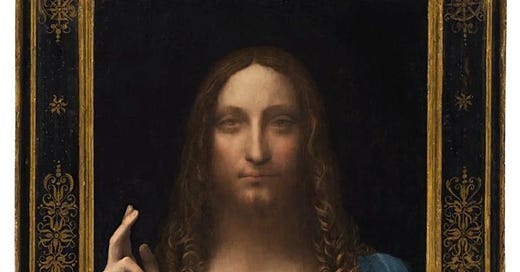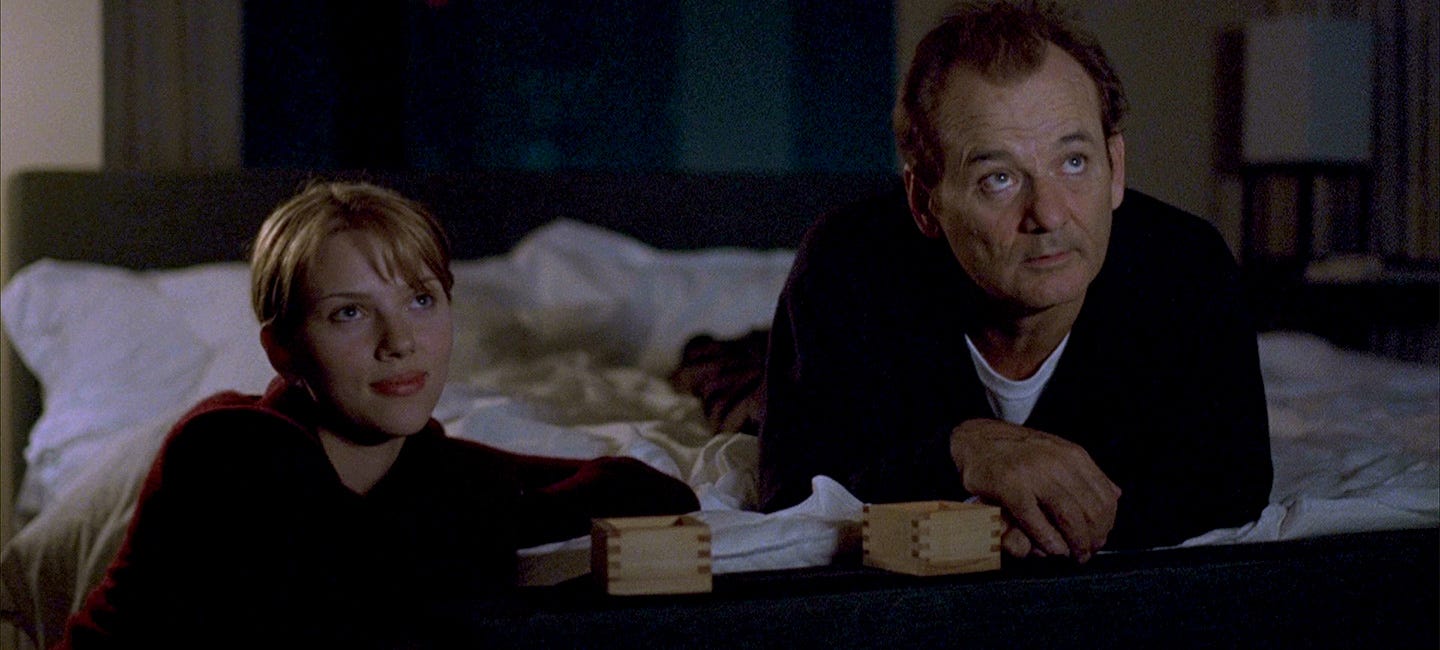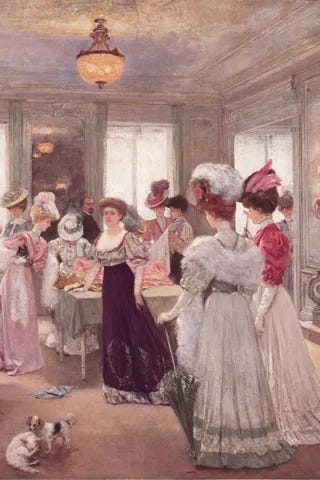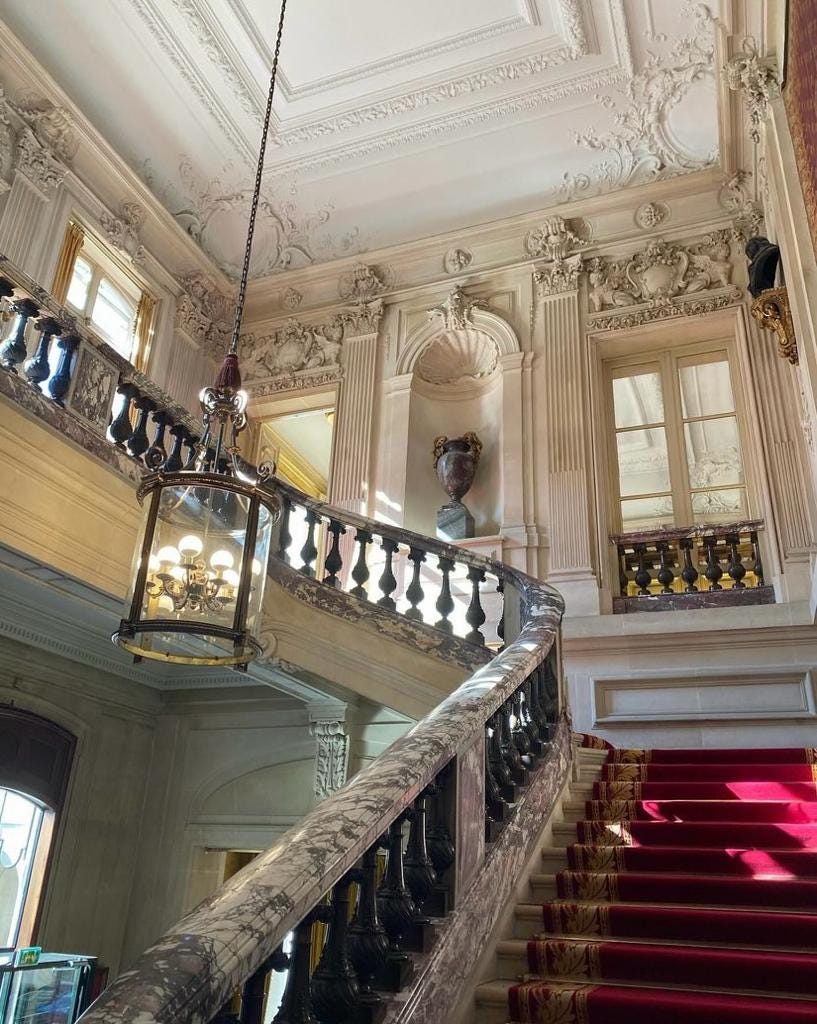Volume 13
Salvator Mundi, attributed to Leonardo da Vinci — Lost in Translation by Sofia Coppola — Challah recipe — Aux Bonheur des Dames by Émile Zola — Wedding planning tips
Happy Sunday and welcome to the thirteenth edition of Giselle daydreams! Today, I’m writing about the most expensive and controversial painting sold at auction (to this date), one of my favourite films by Sofia Coppola besides Marie-Antoinette, and an immersive novel by Émile Zola which delves into an insightful portrayal of a pivotal period in French history. Last but not least, I’m finally sharing my Challah recipe and some wedding-planning tips. Enjoy!
Art
Salvator Mundi, attributed to Leonardo da Vinci, painted circa 1500
I remember seeing The Last da Vinci while I was working at Christie’s back in 2017 in London before it flew to New York where it was auctioned. I was immediately intrigued by this work. It had a je ne sais quoi which made question whether Leonardo painted it or not.
Salvator Mundi is a masterpiece attributed to Leonardo da Vinci which has garnered significant attention for its artistry, historical significance, and the mystery surrounding its attribution.
Salvator Mundi stands as a testament to Leonardo da Vinci's artistic genius and his exploration of religious themes.
Salvator Mundi portrays Jesus Christ as the Savior of the World. He is shown in half-length, dressed in Renaissance-style robes, and is making a blessing gesture with his right hand while holding a transparent globe on his left. The use of chiaroscuro (the play of light and shadow) and the meticulous attention to detail in rendering textures, such as the hair and fabric, are characteristic of Leonardo's artistic style.
The painting reflects the Christian theological concept of Jesus as the Savior of the World. The globe he holds represents the Earth, emphasising his role as the Redeemer of humanity. The blessing gesture adds a sense of divine authority, capturing the spiritual essence of the subject.
Leonardo da Vinci was renowned for his pursuit of realism and naturalism in art. In Salvator Mundi, this is evident in the lifelike depiction of Christ's face, hair, and the translucency of the orb he holds. The artist's anatomical precision and keen observation of nature contribute to the painting's sense of authenticity.
The painting's history includes periods of obscurity and changes of ownership. It was rediscovered in 2005 and subsequently underwent extensive restoration. In 2011, Salvator Mundi was authenticated as a work by Leonardo da Vinci by a group of art experts. However, the attribution has been the subject of scholarly debate.
In November 2017, Salvator Mundi was auctioned at Christie's in New York and set a record for the most expensive painting ever sold, reaching a price of around $450.3 million. The sale brought attention to the rarity and desirability of da Vinci's works, contributing to the mystique surrounding the artist.
Despite its authentication, the attribution of Salvator Mundi to Leonardo da Vinci has faced skepticism from some art historians and scholars. Some have raised questions about the extent of restoration and the overall condition of the painting. The mystery surrounding the painting, along with its high-profile sale, has led to ongoing discussions about the authenticity and value of the work.
The painting's historical journey, from obscurity to a record-breaking auction, adds to its mystique and continues to capture the fascination of art enthusiasts and scholars alike. Salvator Mundi continues to be a subject of fascination and scholarly inquiry, not only for its artistic qualities but also for the controversies and questions that surround its attribution and history.
Cinema
Lost in Translation by Sofia Coppola (2003)
Sofia Coppola is probably my favourite female film director, and after seeing Marie-Antoinette (2006), I decided to watch more of her films. I also became obsessed with visiting the bar at the Park Hyatt Hotel when I visited Tokyo in 2015. I did not realise as I was doing my research that the film is 20 years old!
I am not trying to stray from telling you more about the film, but I want to emphasise how quintessential Tokyo’s most famous luxury hotel is in context of this film, and two decades after the film's release, its magic has remained untouched and still resonates to visitors. If you ever travel to Tokyo, you will encounter something that I did not encounter in Europe, the bustling Shinjuku district, which is also an experience of its own. When entering this magical bar located on the hotel’s 41st floor, you will be enchanted while penetrating the 4-story glass atrium lobby and its mesmerising floor-to-ceiling glass windows. That is where I experienced the true magic of Tokyo, which Sofia Coppola has captured in her film.
Lost in Translation is a film written and directed by Sofia Coppola, released in 2003. The film marked her second directorial effort, following her debut with The Virgin Suicides (1999). The film follows the story of two characters, Charlotte and Bob, played by Scarlett Johansson and Bill Murray, respectively. Charlotte is a young woman accompanying her husband, a photographer, on a business trip to Tokyo. Bob is an aging actor in town to shoot a commercial. The two characters, feeling somewhat adrift in their lives, form a unique and deep connection as they navigate the unfamiliar and somewhat alienating environment of Tokyo.
The film depicts the profound sense of isolation and alienation experienced by both main characters, Charlotte and Bob, in the bustling and unfamiliar city of Tokyo. Their feelings of displacement are exacerbated by the language barrier and cultural differences, creating a sense of being lost in a foreign environment.
The heart of the film lies in the unexpected and deep connection between Charlotte and Bob. Despite the age difference and differences in their life stages, they form a unique bond that transcends conventional relationships. The platonic nature of their connection allows for a deeper exploration of emotional intimacy and shared experiences.
Tokyo is portrayed as a vibrant and surreal backdrop that reflects both the beauty and the disorienting aspects of a foreign culture. Sofia Coppola uses the cityscape to mirror the characters' internal states, emphasising their emotional experiences against the backdrop of the dynamic city.
The film explores the challenges of communication, both verbal and non-verbal. The characters struggle to connect with those around them, and even when they do, there is often a sense of miscommunication or cultural misunderstanding. The famous whisper scene near the end of the film encapsulates the theme of unspoken connections and the beauty of shared moments.
Lost in Translation delves into existential themes, questioning the meaning and purpose of life. The characters are at crossroads in their lives, and the film explores the existential angst that can come with uncertainty.
Sofia Coppola is praised for her subtle and atmospheric storytelling. The film relies on nuanced performances, evocative visuals, and a carefully chosen soundtrack to convey emotions and capture the mood. The film has had a lasting cultural impact and is often cited as a modern classic. It resonated with audiences for its exploration of the human condition and its portrayal of the complexities of human relationships.
The film explores the transient nature of connections and the impact of brief encounters on one's life. The characters' time together in Tokyo is fleeting, and the film doesn't necessarily provide tidy resolutions.
The cinematography, led by Lance Acord, plays a crucial role in creating the dreamlike atmosphere of the film. The use of soft lighting, reflective surfaces, and the choice of locations contribute to the film's unique visual style.
Lost in Translation is celebrated for its subtle storytelling, memorable performances, and the way it captures the universal experience of feeling disconnected in a foreign environment. It remains one of Sofia Coppola's most acclaimed works, and appreciated for its nuanced exploration of themes such as loneliness, connection, and cultural disorientation of the human experience.
Recipe
Challah
I'm not the only who makes Challah. Nonetheless, for those who had the pleasure to taste it over a Friday night dinner, without blowing my own trumpet, I make a pretty decent Challah that each of my guests devoured!
Without further due, I'm finally sharing my awaited Challah bread recipe.
There are a few schools and recipes which involves not activating the yeast or nor using eggs. In my recipe, I activate the yeast and I use eggs, because it gives me the tastiest Challah.
Ingredients:
1kg of plain flour
420ml of lukewarm water
7g of dry yeast
3 eggs
110g sugar + 1tsp for the yeast
100g olive oil
1 tbsp salt
Toppings: I usually use sesame seeds, poppy seeds or za’atar
Instructions:
Start by putting the dry yeast and the sugar in a mixing bowl and add the lukewarm water. Let it activate for about 10min.
This is when your stand mixer is particularly helpful if you don’t enjoy kneading the dough. Prior to owning my iconic black Kitchenaid, I would manually do it and I still obtained satisfaction with the end results, minus some soreness in my arms!
Place the flour, 2 eggs, olive oil and sugar in your stand mixer bowl. Once the yeast is activate, pour gently the mixture and using a low setting, start to knead the ingredients for about 3min.
Add the salt and proceed to knead the dough for another 5min.
Form a ball with your dough and add extra flour so the dough doesn’t get sticky.
Cover your dough with a clean tea towel and place the bowl in your oven (which is turn off at this stage) for at least an hour. Alternatively, you can let your dough ferment in your fridge overnight.
Now it’s time to braid your bread. On a floured surface, I cut the dough into small balls of 80g each. I usually make a 3-strands challah as I’m not a master of kneading yet.
Once you’re done braiding, place the challah on a tray with parchment paper. Let the dough rest, for at least 30min.
Preheat your oven to 180c. Meanwhile, whisk the egg and brush the mixture on the bread using a brush. Then you can add your topping of choice. I usually opt for sesame or poppy seeds, or za’atar.
Place your challah in the oven for 18min.
Remove from the oven and let it cool down.
Try not to devour it before Friday night!
I hope you enjoyed this recipe and that you will make it too!
Literature
Aux Bonheur des Dames by Émile Zola (1883)
Émile Zola features among my favourite French author and this book the one I enjoyed reading the most. I discovered Zola in French literature class when I had to read Germinal, another prominent work of his.
Au Bonheur des Dames is a novel written by Émile Zola, first published in 1883. The title is translated to The Ladies' Paradise. It is part of Zola's Rougon-Macquart series, which explores in detail the impact of industrialisation, capitalism, and the rise of the department store on French society during the Second Empire.
The novel is set in Paris during the late 19th century, a period of significant social and economic change. The story unfolds against the backdrop of the rise of department stores in the city.
The narrative revolves around the department store Au Bonheur des Dames, owned by Octave Mouret. The store symbolises the emergence of modern consumer culture and the impact of capitalism on society. Au Bonheur des Dames, serves as a powerful symbol in the novel. It represents the changing landscape of retail and the emergence of modern consumer culture. Zola uses the store to illustrate the allure of progress and the challenges it poses to traditional businesses.
Zola explores the transformation of retail and the effects of the growing consumer culture. The department store becomes a symbol of progress and modernity but also represents the potential social and economic drawbacks. Zola's work is a commentary on the effects of capitalism on both individuals and society. The expansion of the department store and the pursuit of profit lead to intense competition, the consolidation of economic power, and the transformation of the social fabric.
Zola uses the novel to provide social commentary on the consequences of progress. Au Bonheur des Dames vividly portrays the social and economic disparities of the time. The depiction of the department store as a powerful force in society reflects Zola's observations on the changing dynamics of the time. The success of the department store is juxtaposed with the struggles of smaller businesses and the hardships faced by workers.
The characters in the novel, particularly Denise Baudu and Octave Mouret, represent different aspects of society. Denise, as an outsider, provides a perspective on the challenges faced by individuals in the rapidly changing urban environment, while Mouret symbolises the ambition and ruthlessness associated with capitalism. The novel follows Denise's experiences as she becomes entwined with the world of the store. The story explores relationships among characters, both personal and professional, and how they are influenced by the competitive and consumer-driven environment of the department store.
The novel grapples with themes of modernity and progress. Au Bonheur des Dames explores themes such as the impact of industrialisation and capitalism, the changing roles of women in society, and the allure and challenges of modern urban life. The allure of the department store represents the excitement and promise of the modern age, while also highlighting the disruptions and challenges it brings to traditional ways of life.
Zola explores the seductive nature of consumerism as the department store uses various tactics to attract customers. The novel delves into the psychology of shopping, advertising, and the creation of desire for material goods. It portrays how the store entices customers through advertising, displays, and the wide variety of products available.
The novel explores the impact of the changing economic and social landscape on human relationships and morality. The competitive environment of the department store leads to complex dynamics among characters, testing their values and principles.
Au Bonheur des Dames reflects Zola’s naturalistic literary style. It examines the characters and society with a scientific and deterministic lens, exploring how external factors shape individual destinies. Zola explores how external factors, such as the changing economic landscape and the influence of the department store, shape the destinies of the characters. The deterministic view of human behaviour is a hallmark of Zola's naturalism.
Zola's work can be seen as a critique of the excesses and challenges associated with modern society. While celebrating progress, the novel does not shy away from depicting the negative consequences, such as the erosion of traditional values and the exploitation of workers.
Au Bonheur des Dames remains a significant work that captures the pulse of a changing society. This rich and complex novel depicts the spirit of its time while offering enduring insights into the societal transformations brought about by industrialisation and the forces of capitalism. It is a compelling exploration of the consequences of progress, the allure of consumer culture, and the complex web of human relationships in a rapidly evolving world. The novel is considered a classic of French literature and is valued for its insights into the societal changes brought about by industrialisation and the rise of consumer culture. It remains relevant for its exploration of themes that continue to resonate in contemporary society.
Tips
Things you need to know when you’re planning your wedding
Wedding season will kick off soon and I thought I might share some useful tips for those getting married or those wondering what is behind the scenes of your special day.
Tip #1 Decide on the budget and put aside 10% for unexpected/last minute expenses. That may not be the most glamorous advice, but thinking of a number you’re comfortable spending is essential, as there are numerous things that you need to think of and spend on when getting married. Something that I kept telling my husband-to-be and my mum was that we should put aside a percentage of that budget for expenses that we would forget adding that would happen outside of our control.
Tip #2 Choose the date and destination and send the save the date as soon as you can. If you’re getting married abroad, this step is vital as your guests will want to book flights and hotels, and not plan holidays when you’re getting married.
Tip #3 Learn how to deal with stress and make compromise. Sorry to break this, but you will have disagreements about the way you want to do certain things on your wedding day, and you will need to be able to sacrifice. It’s useful to have a list of non-negotiable, and for the rest, try to find a middle ground with your partner, and your families.
Tip #4 Book your suppliers early. This may sound obvious, but I was flabbergasted when 10 months prior to my wedding, as I was looking for makeup artists in Paris, one of them told me she was already booked, and the other one (my number one choice actually) told me she had a prior engagement in the morning but could do my makeup and my mum’s makeup early afternoon. Insane right? The interesting part, wedding venues had more availabilities!
Tip #5 Remember to enjoy your day as this goes back so quickly and even if you hire photographers and videographers, they are just capturing the moment, but you are living it.
I could go on and on on the topic as I had 11 months to plan my wedding during Covid and lockdown, but I will stop here. However, if you’re interested in more tips, leave a comment below, and I’ll create more content in the future on the topic.
I hope you enjoyed the thirteenth edition of Giselle daydreams.
If you aren’t already, you can follow me on Instagram.
Giselle xx











Love it!!
super , i love very much